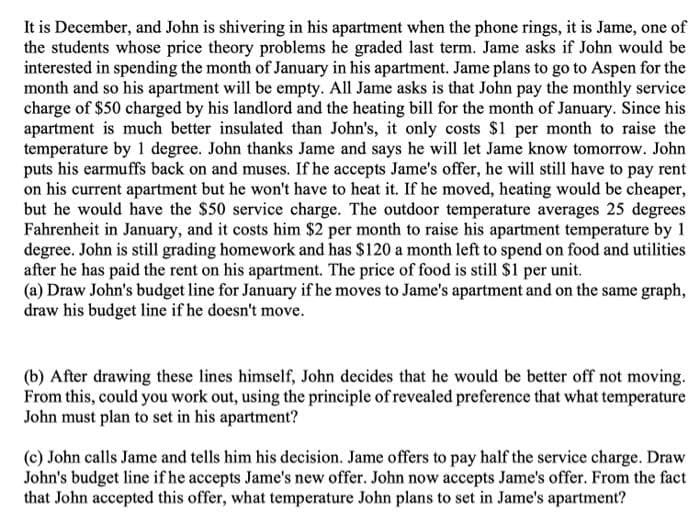(a) Draw John's budget line for January if he moves to Jame's apartment and on the same graph, draw his budget line if he doesn't move. (b) After drawing these lines himself, John decides that he would be better off not moving. From this, could you work out, using the principle of revealed preference that what temperature John must plan to set in his apartment? (c) John calls Jame and tells him his decision. Jame offers to pay half the service charge. Draw John's budget line if he accepts Jame's new offer. John now accepts Jame's offer. From the fact that John accepted this offer, what temperature John plans to set in Jame's apartment?
(a) Draw John's budget line for January if he moves to Jame's apartment and on the same graph, draw his budget line if he doesn't move. (b) After drawing these lines himself, John decides that he would be better off not moving. From this, could you work out, using the principle of revealed preference that what temperature John must plan to set in his apartment? (c) John calls Jame and tells him his decision. Jame offers to pay half the service charge. Draw John's budget line if he accepts Jame's new offer. John now accepts Jame's offer. From the fact that John accepted this offer, what temperature John plans to set in Jame's apartment?
Chapter4: Utility Maximization And Choice
Section: Chapter Questions
Problem 4.2P
Related questions
Question

Transcribed Image Text:It is December, and John is shivering in his apartment when the phone rings, it is Jame, one of
the students whose price theory problems he graded last term. Jame asks if John would be
interested in spending the month of January in his apartment. Jame plans to go to Aspen for the
month and so his apartment will be empty. All Jame asks is that John pay the monthly service
charge of $50 charged by his landlord and the heating bill for the month of January. Since his
apartment is much better insulated than John's, it only costs $1 per month to raise the
temperature by 1 degree. John thanks Jame and says he will let Jame know tomorrow. John
puts his earmuffs back on and muses. If he accepts Jame's offer, he will still have to pay rent
on his current apartment but he won't have to heat it. If he moved, heating would be cheaper,
but he would have the $50 service charge. The outdoor temperature averages 25 degrees
Fahrenheit in January, and it costs him $2 per month to raise his apartment temperature by 1
degree. John is still grading homework and has $120 a month left to spend on food and utilities
after he has paid the rent on his apartment. The price of food is still $1 per unit.
(a) Draw John's budget line for January if he moves to Jame's apartment and on the same graph,
draw his budget line if he doesn't move.
(b) After drawing these lines himself, John decides that he would be better off not moving.
From this, could you work out, using the principle of revealed preference that what temperature
John must plan to set in his apartment?
(c) John calls Jame and tells him his decision. Jame offers to pay half the service charge. Draw
John's budget line if he accepts Jame's new offer. John now accepts Jame's offer. From the fact
that John accepted this offer, what temperature John plans to set in Jame's apartment?
Expert Solution
This question has been solved!
Explore an expertly crafted, step-by-step solution for a thorough understanding of key concepts.
Step by step
Solved in 5 steps with 20 images

Knowledge Booster
Learn more about
Need a deep-dive on the concept behind this application? Look no further. Learn more about this topic, economics and related others by exploring similar questions and additional content below.Recommended textbooks for you


Principles of Economics 2e
Economics
ISBN:
9781947172364
Author:
Steven A. Greenlaw; David Shapiro
Publisher:
OpenStax



Principles of Economics 2e
Economics
ISBN:
9781947172364
Author:
Steven A. Greenlaw; David Shapiro
Publisher:
OpenStax


Microeconomics: Principles & Policy
Economics
ISBN:
9781337794992
Author:
William J. Baumol, Alan S. Blinder, John L. Solow
Publisher:
Cengage Learning

Economics (MindTap Course List)
Economics
ISBN:
9781337617383
Author:
Roger A. Arnold
Publisher:
Cengage Learning
